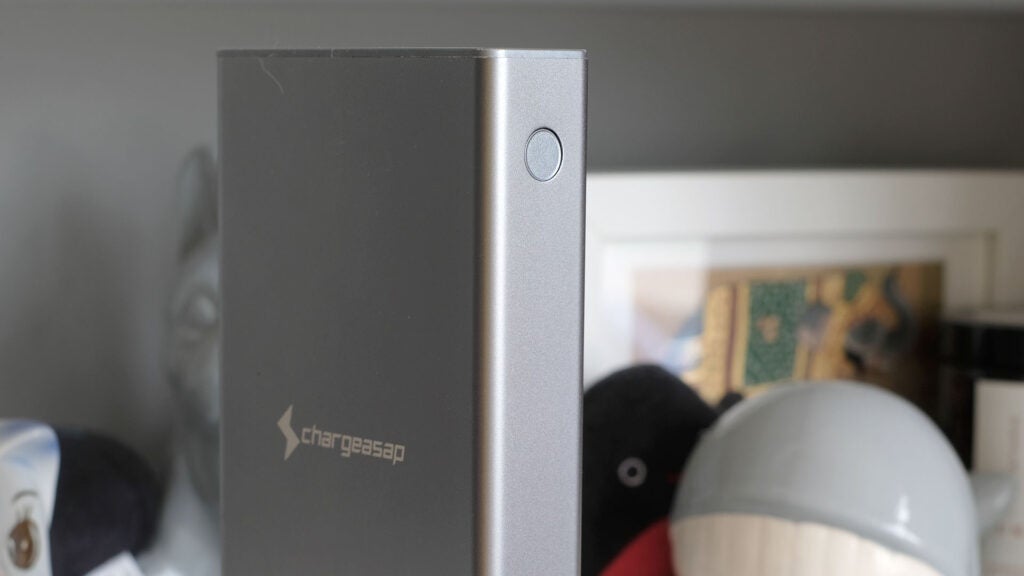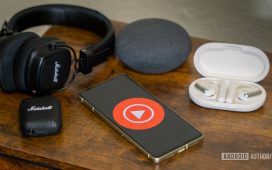Verdict
This is a capable travel-ready battery that can charge a wide array of brands’ phones, and laptops, at high speeds. However, it’s quite large for its capacity and while the main body of the casing is tough aluminium, other parts aren’t quite as durable as is ideal. There were also issues with getting Apple devices to charge wirelessly at decent speed during testing.
Pros
- High capacity
- Good compatibility across brands
- Handy no-nonsense display
- High claimed charge cycle count
Cons
- No ruggedisation or water resistance
- We had issues with wireless charging speeds
- It’s big and fairly heavy
- Output efficiency no better than good cheaper rivals
-
Graphene batteryOften called a wonder tech, graphene-infused batteries allow for faster charging with less heat build-up, and contribute to a longer-lasting cell. -
OLED displayA neat monochrome OLED screen shows the charging speed of all ports, and how much juice the Chargeasap has left. -
25,000mAh capacityThis external battery gets fairly close to the capacity limit allowed on airplanes, with equivalent to 92Wh.
Introduction
The Chargeasap Flash Pro Plus is an external battery that has an unusual combo of features. It’s massive, but it also has prominent wireless charging pads too. Two of ‘em.
Chargeasap also uses a graphene tech battery, which is meant to help control temperature, allowing for faster charging times.
This £258/$289 battery (mostly) does what it claims, but it is pretty large for its capacity and is far more expensive than the high-spec options from Anker and Ugreen. Still, it’s going to be ideal for frequent work travellers, particularly Apple fans.
Design
- Mixed plastic and aluminium casing
- 583g
- Case included (and recommended)
The Chargeasap Flash Pro Plus looks like a huge iPod drawn from a child’s hazy memory. It’s just under 16cm tall, and is around 29mm thick according to my tape measure.
Of course, that likeness is only because of the Chargeasap Flash Pro Plus’s wireless charging pads. There are two of these, and the top one brings back memories of the iPod classic’s touchpad.


There’s no plugging earphones into this thing, though. The Chargeasap Flash Pro Plus has an aluminium casing, but outside of cutting out the parts for the wireless charge pads, it seems a simple design.
The top and bottom plates, the end caps, are plastic rather than metal. And the wireless pads are plastic. Their finish seems easy to scrape or scratch too. I’d be quite upset if I’d spent £260 on this battery and managed to damage it this early.


You should use the included case whenever you travel, but these parts still feel too fragile. There’s also no water resistance, which remains a disappointingly rare feature in this category.
The Chargeasap Flash Pro Plus weighs 590g, minus case, around three times the weight of an average phone.
There is an OLED screen up top, and it’s quite a simple display compared to the best of Anker. You press a button on the side to light this screen up, and there’s only one display page.
It shows the battery level, the temperature, the wattage, voltage and current for the cabled outputs. And the wattage for the wireless pad.


There’s a whole heap of data here — all the crucial stuff. It doesn’t have the number of charge cycles info on offer from Anker’s best, though, which is a neat addition.
We get four outputs here. The main one is a 100W USB-C, which is the one you use to charge the Chargeasap Flash Pro Plus itself. There’s a 20W USB-C, a 60W USB-C and a 50W USB-A.
Surprisingly, this last USB-A brings one of the Chargeasap Flash Pro Plus’s coolest features. It supports the SuperVOOC standard used by OnePlus, OPPO and Vivo, and the Huawei (only up to 22.5W) fast-charging standard.


I typically find phones from these brands don’t get anywhere near the top speed with other popular battery packs. There’s still a limit here, though.
50W max output isn’t close to the output of the latest models. The OnePlus 12 has up to 100W charging, and the tech is capable of up to 240W in its latest variant. Still, 50W is better than you’ll get when plugging a fast-charging OnePlus into the USB-PD socket you might find on a rival.
The USB-A isn’t just for SuperVOOC either. It also supports Qualcomm’s QuickCharge 3.0, used by loads of slightly older phones from the days before USB-PD (Power Delivery) became the standard.


Chargeasap’s Flash Pro Plus doesn’t quite have the chops to output from all these USBs, at max speed, simultaneously. But it’s not that far off. The max is 190W. And the 60W secondary USB means you can fast charge a laptop and a phone at the same time at a respectable speed.
What about those front charging pads? The “Plus” model is made for Apple fans, so there’s a MagSafe-compatible 15W iPhone charger up top, and a 5W for Apple Watch one below.


Chargeasap’s non-Plus version has a single non-MagSafe pad. You long-press the power button on the side to activate the wireless pads, in order to stop them leeching energy when not needed.
My test iPhone was only able to reach 8W according to the Chargeasap’s own display. My best guess is an iOS update has an issue with the third-party implementation of Apple’s MagSafe tech here.
Also, don’t be fooled by Chargeasap photos that make it appear as though the lower Apple Watch pad is indented. It isn’t. It’s perfectly flat.
Performance
- Just shy of 80% tested efficiency
- Long claimed longevity
- 90-minute charge time
My main curiosity about the Chargeasap Flash Pro Plus was whether the vaunted graphene battery tech would lead to incredible efficiency. It doesn’t, based on my testing, but the results aren’t too bad.
I recorded 93.65Wh going into the battery when charging. And that took around 90 minutes — a little longer than the claimed 70 minutes. However, this was fully charging the thing, to the point it stops taking in power.
When charging other devices, it spat out 74.61Wh, meaning an efficiency score of 79.6%. I like to see 80% or above in these higher-price battery packs, meaning less power is lost through heat build-up and other factors.
It’s a little disappointing to see the seriously expensive Chargeasap Flash Pro Plus beaten by the Anker Prime Power Bank 20,000mAh, which managed 82%. But these runs will be slightly different every time, as they are affected by environmental factors.


Graphene doesn’t provide any magical efficiency properties compared to other high-quality rivals out today, then, but Chargeasap does promise 2000 charge cycles. This is much higher than the “300-500” Anker uses as a general guide before its units drop to 80% capacity.
There’s another notable bit here too. The Chargeasap Flash Pro Plus’s capacity is very nearly as high as you’d ever want to go for a battery pack intended for travel.
99Wh is the highest allowed on an airplane, and the Chargeasap Flash Pro Plus’s official capacity is 92.5Wh, just a shade under what I recorded going into the battery when charging. It’s this part that’s more efficient, then, it seems.
I can imagine being asked what this thing is by airport security workers. Any proof? Absolutely not, and I haven’t had the chance to fly with the Chargeasap. It does seem made for such an eventuality, although it’s more at home flying between New York and London than out into the rainforest.
Latest deals
Should you buy it?
You want great cross-brand charging
Chargeasap goes the extra mile in supporting reasonably fast charging for brands like OPPO, OnePlus and Huawei, often left out in these external batteries.
You want a rugged battery
While ideal for travelling in some respects, the design of this battery could be more rugged, and its capacity per cubic centimetre is not the best around.
Final Thoughts
The Chargeasap Flash Pro Plus largely does what it promises, beyond being unable to charge my test iPhone wirelessly at full speed.
It’s a capable and powerful charger, and particularly adept at fast-charging phones from different brands — if not to anything like the top speeds of the higher-end models.
There is an uncomfortable collision of cost and durability here, though. There are plastic parts with a painted finish likely to scrape off before too long unless you are very careful. A price this high also makes you long for more external batteries with at least basic water resistance.
How we test
We thoroughly test every power bank at Trusted Reviews, using a USB Voltimeter to not only test elements like maximum wattage but to measure its total output to gain insight into efficiency and more.
Tested input, output, maximum wattage and more using a USB voltimeter
Charged both phones and laptops during testing
FAQs
There’s no water resistance rating.
It has the speed and the capacity to fully fast-charge plenty of models.
It supports MagSafe charging, although we had trouble getting it to hit MagSafe-ready speeds.









